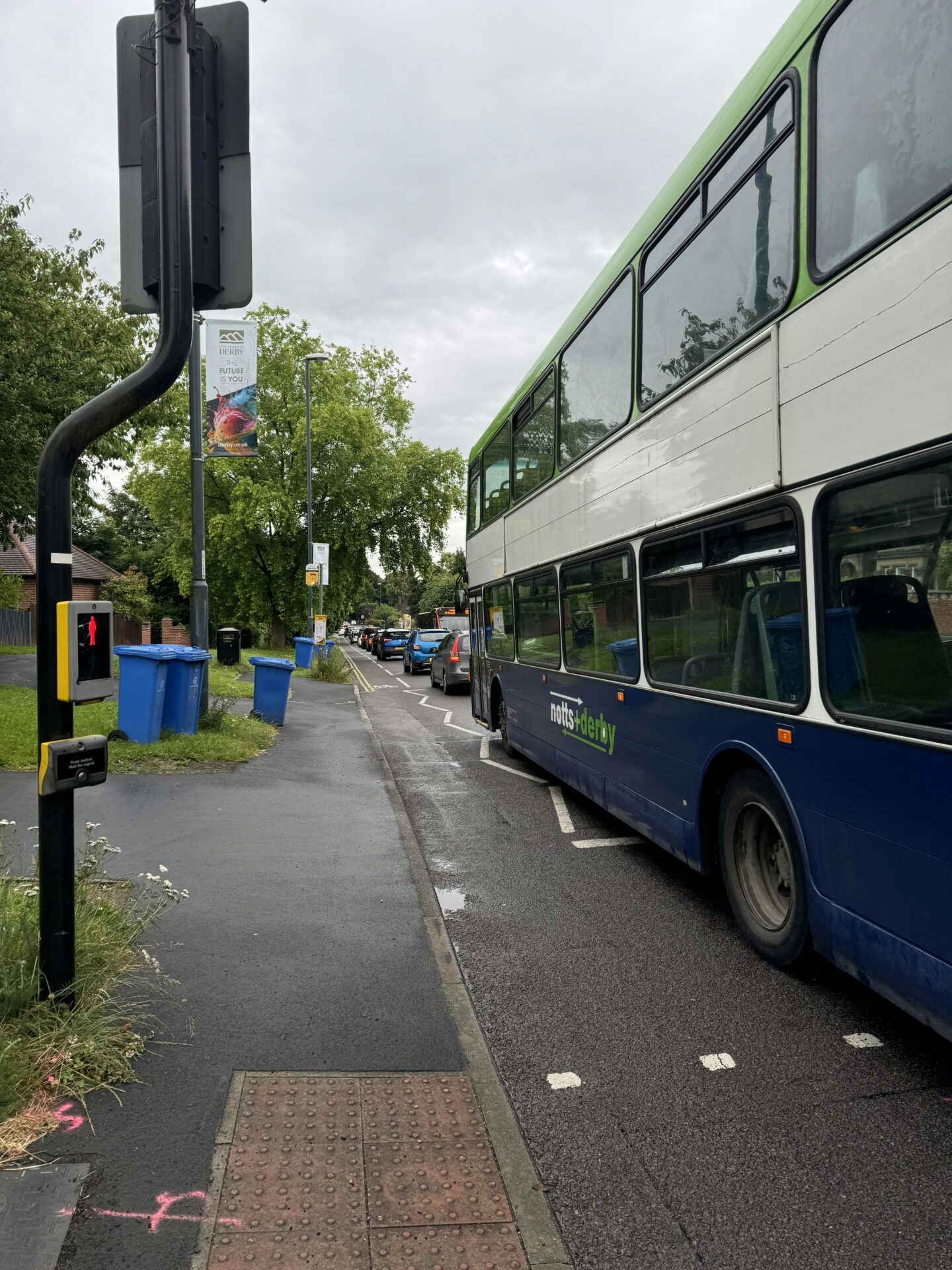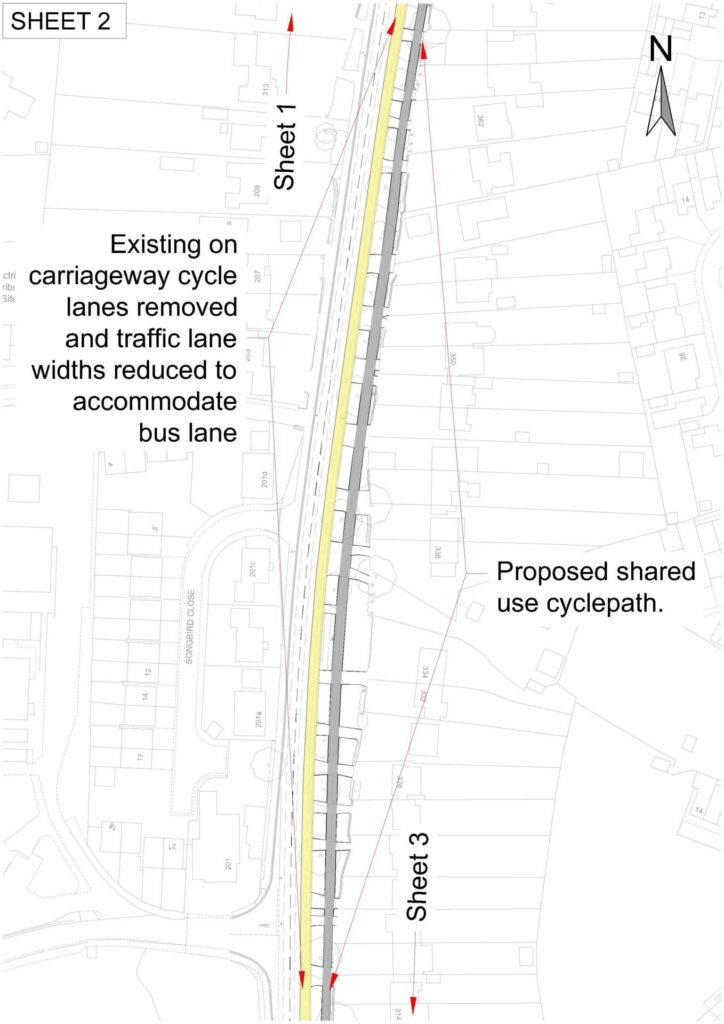Updated: May 2025
May 25 update: The City Council have published the results of the feedback exercise and they can be seen here.
It is good to see that the future plans include “Facilities for pedestrians and cyclists along Duffield Road will be reviewed with a view to improving safety.”. Also positive that the long standing (8+ years) problems with illegal parking on yellow lines within the existing cycle lanes is identified as an issue and something that will be included in the review.
March 2025 update: Derby City Council have announced that, as a result of public feedback, they will not be proceeding with their plans for both Duffield Road and Osmaston Road. Instead they will be exploring alternative options including the installation of bus detection technology at Five Lamps, light segregation of the current marked cycle lanes, potential upgrades of pedestrian crossings, and adding kerbside parking on the A6.
Derby City Council are proposing to introduce a bus lane on Duffield Road in the area of St Benedict’s school (Darley Abbey) and, as part of the road changes, create a shared pedestrian / cycle route on the existing pavement on the east side of the road.
We’ve examined the plans published so far and have met with Council officers responsible for designing the proposals. We are very grateful for the time of the Council officers.
The Council undertook a consultation exercise for their proposals with a deadline for completion of 27th October 2024. They are now (November 2024) reviewing the feedback. The Council consultation site can be found here. Note, feedback is no longer being accepted.
Derbyshire Live have reported on the proposals and their article can be found here.
Our approach has been to examine whether cyclists are better off with the current situation or the proposed changes and also to consider whether there is a better solution that currently hasn’t been proposed.
In principle, Derby Cycling Group would be supportive of encouraging bus usage and removing obstacles (e.g. congestion) impacting on buses. Our views on the proposals are focused on the cycling aspects and consider whether the proposals will improve (or degrade) the environment for cyclists.
We have sympathy for the Council officers trying to find a solution that improves things for bus users, pedestrians and cyclists within the constraints that they have to work with.
Our conclusion is that, while facilitating bus travel is good in principle, this cannot be at the expense of cyclists. Therefore, the proposals cannot be supported as they stand.
Current situation
Currently Duffield Road consists of two wide lanes for all traffic with painted, advisory cycle lanes on each side of the road. Painted lines are no longer recommended by national standards (in some cases they are more dangerous than having no lanes) but with the road being wide there are relatively few problems with close passing by motor traffic. However, the perceived threat of cycling within an unprotected lane on a busy road is likely to be off-putting for many potential cyclists. There is currently no bus lane.
It should be emphasised that the existing situation does not meet current national recommendations. Duffield Road has around 12,000 vehicles per day, meaning any unprotected on-carriageway cycle lanes score a “critical fail” in LTN 1/20 CLoS and Active Travel England cycle scheme assessment tools: On-carriageway options are unsafe and unusable by most potential cyclists. LTN 1/20 fig 4.1 (below) shows that with over 10,000 vehicles per day and a speed limit of 30mph, a minimum protection of light segregation is required to meet the guidelines.
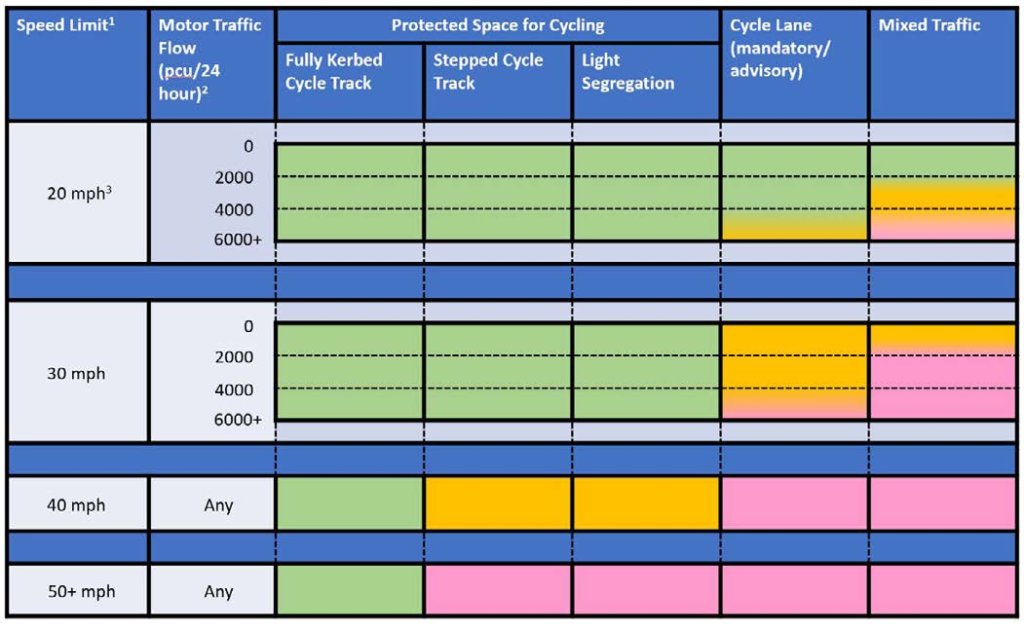

Each side of the road has double yellow lines denoting no parking and these are generally well respected. However, on occasion, contractor’s vehicles (e.g. builders, delivery vehicles, etc.) park within the painted cycle lane (and block it) requiring cyclists to move towards the centre of the road.
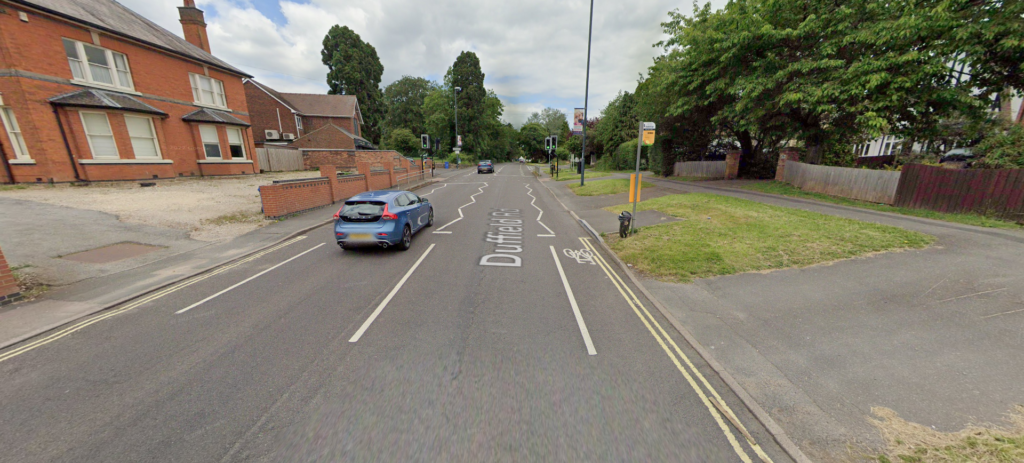
For a period of around an hour each afternoon, the no parking signs are ignored by vehicles waiting to pick up students from St Benedict’s School. During this period, the cycle lane on the northbound side is unusable. This requires cyclists to travel near to the centre of the road to avoid the parked cars and the likelihood of any of them opening their doors suddenly. More recently this illegal parking has also extended to the southbound side. Derby Cycling Group has been fighting to get the Council to address this illegal and dangerous parking for many years (at least since 2017) but so far without success.

The pavement on the east side of the road is of reasonable width and is surrounded by wide grass verges and, while not legal, some cyclists do cycle on the pavement to avoid the perceived danger of the road.
Near to Ferrers Way, there is an existing Toucan crossing taking Orbital Route 66 across Duffield Road and connecting Park Farm and Darley Abbey.
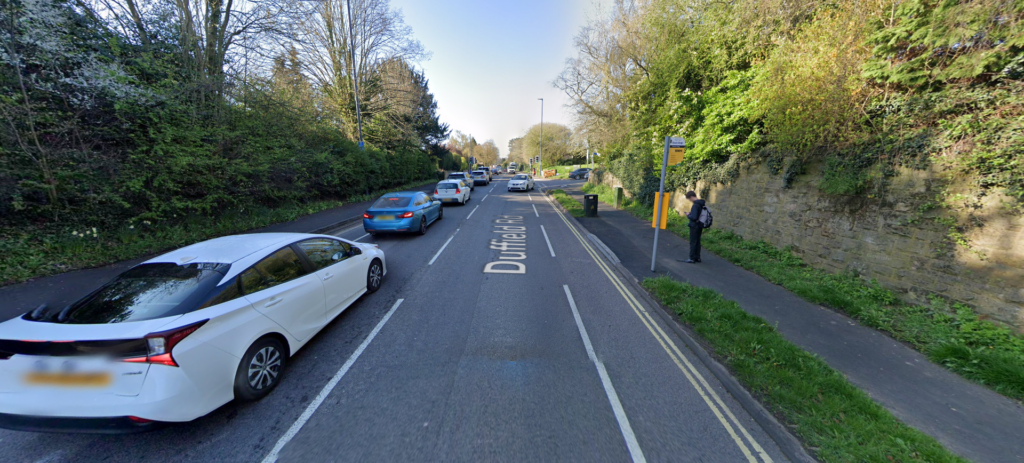
The existing minimal provision of painted cycle lanes is disconnected from ongoing routes in most directions. The A6 south of Broadway Island is narrow, has no cycling facilities, and has high walled edges for parts of the southbound carriageway. The A6 north of the planned scheme takes cyclists around Palm Court (A38 intersection) Island – a notorious hot spot for accidents and very intimidating for cyclists.
Proposals
The proposals are to create an additional lane within the existing road space (the southbound bus lane) and to use the remaining space for 2 motor lanes which will necessarily be narrower than currently. This bus lane will run between approx Ferrers Way to just north of Mile Ash Lane.
Creation of an additional lane on the road (northbound motor traffic, southbound motor traffic and southbound bus lane) will mean that there will be no space for the existing advisory (painted) cycle lanes within the road space.
To provide a solution for cyclists to replace the on road lanes, the existing pavement on the east side of the road will be widened (where possible) and designated as a two way shared path (i.e. for cyclists traveling in both directions as well as pedestrians). There is no intention to segregate the cyclists from the pedestrians. If possible this shared use path will be 3m wide. However issues with mature tree roots, the bus shelter already in place, residents’ encroachment onto the existing verge, and other engineering issues mean that, in many places, the width will be less than 3m (maybe 2m at some points).
Our comments
The pros and cons of the scheme from a cycling point of view have been considered from each direction:
Southbound Cyclists
Traveling southwards from Palm Court Island cyclists will initially use the existing painted cycle lane which will be retained until the bus lane starts near to Ferrers Way. From there cyclists will either make use of the bus lane or take to the shared use path (upgraded pavement).
The Council have many constraints and issues to overcome to create a high quality shared use path. LTN 1/20 provides guidelines for how shared use paths should be created and it seems unlikely that the Council will be able to achieve all of these recommendations. In particular the issues include:
- A restriction that, realistically, no, or very few, mature trees can be removed.
- A need to protect the mature tree roots (and also prevent surface damage to the path from the roots) which will mean building the path surface up above the roots – quite significantly in places.
- Providing continued access to the many driveways along the east side of Duffield Road.
- Some issues where householders have encroached onto the Council land (the wide verges) and which may impact on how wide the shared use path can be constructed. For example, block paving built beyond the householder’s land or hedges grown on the verge. Legally, the Council could probably regain control of “their” land but there will be a lot of protest to overcome from the existing householders.
- the fact that funding for the changes is from a pot of money for creating bus lanes.
The bus lane can be used by cyclists but the width is likely to be much less than the national standards recommend (they state that bus lanes that include cyclists should not be less than 3.9m in width). The implication of this is that any cyclists using the bus lane are likely to have a slow moving, and possibly impatient, bus close behind. It is yet to be decided the hours of operation of the bus lane – either 24 hours or just for peak time.
The bus lane will end before Mile Ash Lane and cyclists will either have to rejoin the motor lane (with no painted advisory lane) or proceed on the shared use path (pavement) and cross over the Mile Ash Lane junction. There is no intention to provide lights to control this crossing nor create a zebra or similar crossing.
South of Mile Ash Lane cyclists will rejoin the painted on road advisory cycle lane from the existing pedestrian crossing (upgraded to a Toucan) to Broadway Island. South of Broadway Island there are no plans for any cycle facilities.
Students cycling to St. Benedicts will not have any facilities to cross Duffield Road by the school and will have to make use of the pavement on the west side of the road between the Toucan near Mile Ash Lane and the school – they will have to push their cycles on this section.
Northbound cyclists
Traveling from the city towards Allestree, cyclists will first encounter the Broadway Island where they will join the existing painted advisory cycle lane.
Progressing northwards, using the advisory lane, cyclists will then reach the traffic light controlled crossing. This will be upgraded to a Toucan and the west side pavement will be modified to allow cyclist access. At this point the cyclist can continue on road (without the advisory cycle lane and within a narrow traffic lane) or cross over the Toucan to reach the shared use path.
One of the major issues with the previous incarnation of the bus lane on Duffield Road was the need to reduce the lane widths to allow for 2 traffic lanes and a bus lane. With the overall width of the road varying around 8.7m to 9.3m each lane will be about 3m wide. This 3m width is insufficient to allow space for a cyclist and a car overtaking the cyclist. Previous experience from 2008 was that Duffield Road is busy (12,000 vehicles per day) and there were few opportunities for cars to pass cyclists using the opposite side of the road. Motorists became impatient having to travel behind a cyclist and dangerous close passes were common. Some cyclists were also intimidated by motorists closely following them and “encouraging” them to move into the gutter to allow minimal room for overtaking.

Those cyclists choosing to use the shared use path will have to negotiate the junction with Mile Ash Lane (no traffic lights are planned) and then take the shared path to the existing Toucan crossing by Ferrers Way. At this point they can cross the road again and resume their journey on the advisory cycle lane that will continue northwards (after the Ferrers Way junction) towards Palm Court Island. To rejoin the advisory lane they will first have to cross Ferrers Way and then rejoin the Duffield Road carriageway.
Using the shared use path will separate cyclists from the motor traffic for the section where the bus lane will exist but will require crossing 4 roads (two via Toucan crossings) as well as many driveway accesses. Overall this solution will provide a much slower route than the current on road advisory lanes but will provide a solution for cyclists not prepared, or able, to cycle on road.
Summary
For southbound cyclists, the option of using the proposed bus lane or the shared use “pavement” path means that the experience is unlikely to be much different from the current situation. The narrowness of the bus lane may mean that cyclists are intimidated by buses if choosing to avoid the shared use path, particularly if the bus lane is not in operation for 24 hours a day.
Northbound cyclists will have a much worse experience than they have with the current situation. Their options will be to either ride in the narrow motor lane (with no advisory cycle lane) or to take the shared use path which will require using two Toucans and crossing 2 uncontrolled junctions (Mile Ash Lane and Ferrers Way). There will be the need to take care at each house driveway along Duffield Road to beware of traffic entering or leaving the driveways. As travel both north and south of the planned works will revert to using the on road painted advisory lanes, it seems very unlikely that northbound cyclists who already have the confidence to use the advisory lanes will choose to use the shared use path as it is so indirect.
The engineering issues with the shared use path mean that it will not meet recommended standards and will be well below the requirements to support 2 way cyclist and pedestrian traffic, a situation likely to lead to conflict. The Government recommendations state that “Creating space for cycling may require the reallocation of space within the highway boundary. Wherever possible, this should be achieved by reallocating carriageway space, not reducing the level of service for pedestrians. Only where there are very wide or lightly-used footways should part of the space be
considered for use by cyclists, and the minimum footway widths recommended in Inclusive Mobility should be retained.” In addition, all the guidance is that pedestrian and cycle routes should be treated separately (even if positioned adjacently) with minimum widths applying to both. The current proposals and physical constraints mean that these requirements will not be achieved.
The fact that the new motor lanes will be much narrower may have an impact on the illegal parking outside St Benedicts as any parked cars will block the full lane and enforcement will be necessary to prevent gridlock.
The plan to upgrade the existing pedestrian crossing near to Mile Ash Lane to a Toucan crossing (for pedestrians and cycles) is welcomed.
Conclusion
We have sympathy for the Council officers trying to find a solution to accommodate a bus lane within the various physical (and political) constraints that they have and would, in principle, support the creation of a bus lane.
However, the impact on cyclists is such that the experience (particularly for northbound cyclists) will be significantly worse than the current situation. The proposals fall well short of the Government recommendations for cycle routes in terms of path widths, mixing with pedestrians, treatment of side roads and driveways, and inadequate road widths. We therefore cannot support the plans as they stand.
The current situation for cyclists does not meet the Government recommended guidelines and nor do the proposed changes. If a solution can be found that provides high quality cycling infrastructure (meeting or close to the Government recommendations) then we would be supportive.
We have no suggestions as to a solution that also incorporates a bus lane (beyond one that requires significant engineering such as widening the highway and removing lots of mature trees) but believe that a cycle friendly solution could be provided by introducing properly segregated lanes on each side of the existing road layout (without a bus lane) for the entire distance between Broadway Island and Palm Court Island. Previous plans (in 2022) suggested some aspects of segregating the cycle lane but had shortcomings in that it was proposed to ignore the parking issues outside St Benedicts and exclude this area from having a segregated cycle lane.
Another solution that would provide immediate improvements for all users of the road (including cycles, buses and other motor traffic) is to enforce the existing no waiting restrictions that are regularly flouted for around an hour during the afternoon of each school day. Removing the parked cars would allow all traffic (including cycles) to flow much more efficiently and safely.
While not directly affecting the Duffield Road proposals, consideration should be given to upgrading the existing footpath through St. Benedicts. This connects Broadway Island to Farnway thereby providing a link for Allestree residents which avoids Palm Court. Upgrading this to allow cycling would provide benefits with no impact on motor or bus traffic.

Hopefully feedback from our members and others can suggest solutions that address some of the issues above and result in improved proposals that provide significant improvements for existing and potential cyclists as well as bus users.

